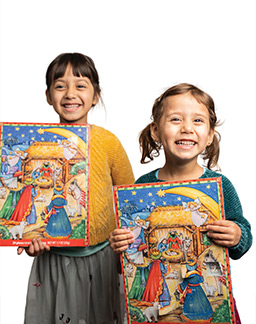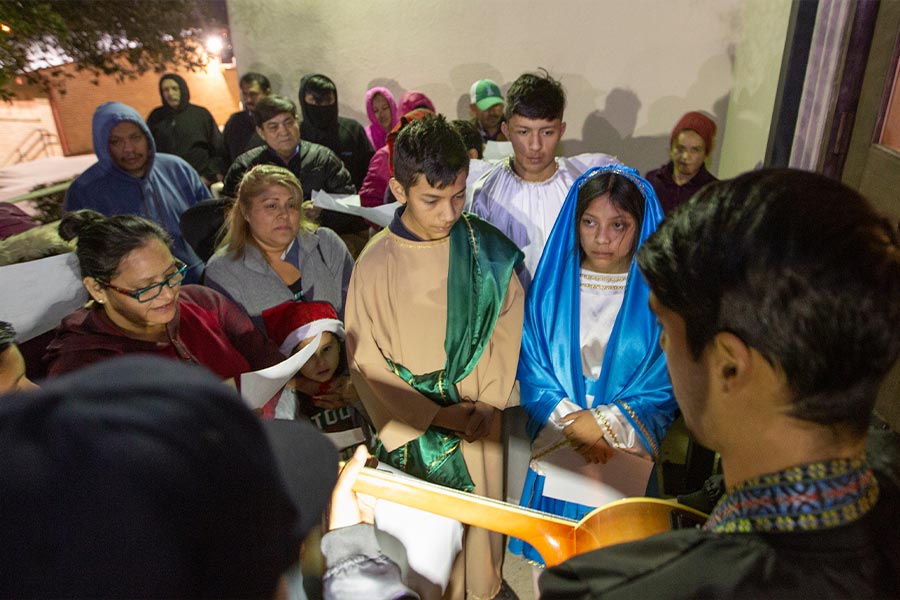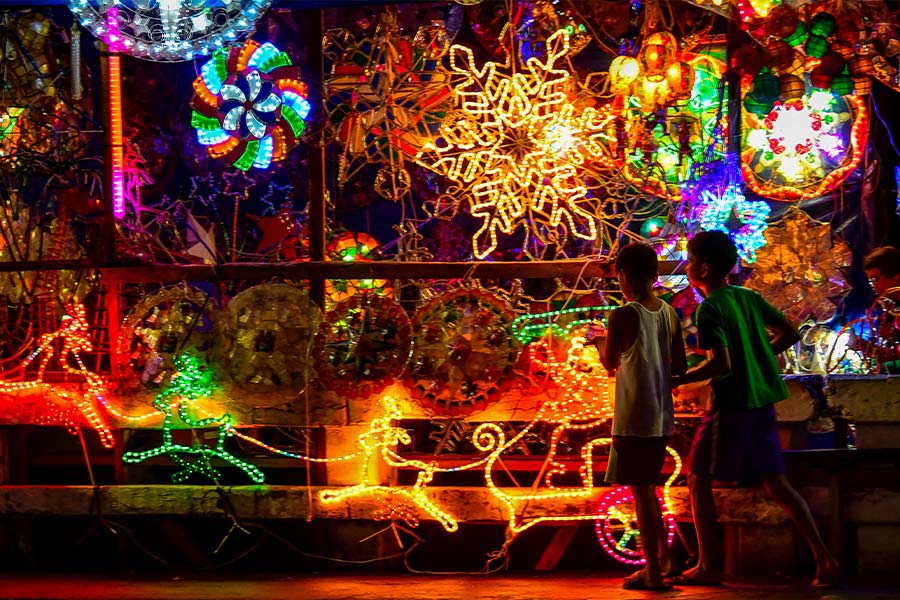Joy around the world: Christmas traditions highlight the birth of Christ

We humans are creatures of habit and delight in remembering the old days. Is it any surprise we have traditions, then?
As an alumnus of the University of North Texas, for instance, we had plenty of those on campus — from the stately, like the lighting of the McConnell Tower, to the kooky, like spotting the famous albino squirrel on the way to an exam in order to receive good luck.
The point is that traditions have existed for millennia because, while they can be fun, they’re a crucial way to build community bonds and pass down values. The same is true for many Advent and Christmas traditions in the Catholic Church. While they originated in vastly different times and places, they all point us to the immense love of a God who made Himself man to be with us.
Germany: The Advent calendar
Though it may seem a commercial phenomenon, the Advent calendar is actually rooted in centuries of religious history.
The Advent calendar traces its roots to mid-19th century Germany — where Christian families would tally chalk marks on the door or wall of their homes, or hang small religious pictures on the windows, to keep track of the days remaining until Christmas.
Gerhard Lang is credited with creating the more ornate printed calendars of today.
Though they were commercialized by Lang in 1908, they kept their faith-driven message. Lang’s first edition of the Advent calendar, for instance, was centered on the theme “In the Land of the Christ Child” and featured small drawings children could cut out and glue onto a picture album of sorts. Unfazed by effort and cost, Lang worked hard to develop new versions of his Advent calendar. These grew to include calendars with little numbered doors which children would open each day.
Hidden behind each door was a Scripture verse or religious image. Eventually, Lang’s calendars even included chocolate pieces and an edition specifically for blind children.
Though they vary widely in their shapes and expressions nowadays, Advent calendars remain more than just a countdown — they’re a warm reminder of the coming birth of the Messiah and highlight the special nature of the Advent season.
Ireland: The light in the window
Drawing on a history filled with hardship and persecution, Irish Catholics founded a tradition that continues today.
The custom of the light in the window comprises either a single candle or a trio of candles placed on the windowsill facing the street. The tradition remains popular in Ireland at Christmastime.
Historians trace it back to British persecution of Irish Catholics in the 17th century. At the time, the British legalized what were known as the Penal Laws. Catholics were prohibited from practicing the faith and priests were prevented from celebrating Mass or teaching the faith. Punishments for breaking the law were severe: imprisonment, confiscation of goods, torture, and death.
The political philosopher, Edmund Burke (1729-1797), in his Tracts relating to Popery Laws, wrote: “There was not a single right of nature or benefit of society which had not been either totally taken away or considerably impaired.”
To continue ministering to the faithful, Irish priests and bishops secretly offered Masses in houses and fields. Around Christmas, Irish Catholics began lighting a single candle in their windows and leaving their front doors unlocked, as a way to discreetly invite priests into their homes to celebrate Mass or to just simply find shelter and food. Some houses placed three candles in one window to represent Jesus, Mary, and Joseph.
After some time, the British became suspicious and questioned the Irish about the practice. The faithful Irish responded that it was a way to welcome the Holy Family during Christmas as they looked for lodging. The British dismissed it as silly superstition and the practice continued being a sign of welcome and hope in Jesus, the light of the world.
Germany: The Christmas tree
The Christmas tree is another tradition that originates in Germany. Based on a mix of legend and historical sources, the story goes that St. Boniface, an English bishop who evangelized in Germany during the eighth century, once found a group of pagans preparing to celebrate the winter solstice by sacrificing a young man under an enormous tree called “Odin’s oak.”
Apparently, St. Boniface was pretty good with an axe. The Catholic Encyclopedia states: “To show the heathens how utterly powerless were the gods in whom they placed their confidence, Boniface felled the oak sacred to the thunder-god Thor…”
Willibald’s The Life of Saint Boniface tells us that with one blow, “the oak’s vast bulk, driven by a blast from above, crashed to the ground, shivering its crown of branches as it fell…. At this sight the pagans who before had cursed, now, on the contrary, believed, and blessed the Lord, and put away their former reviling.”
According to legend, after the mighty oak fell, the astounded pagans asked Boniface how to worship the birth of the one, true God. He pointed at a small fir tree that had miraculously stayed upright in the midst of the debris from the broken oak and said:
“This little tree, a young child of the forest, shall be your holy tree tonight. It is the wood of peace… It is the sign of an endless life, for its leaves are ever green. See how it points upward to heaven. Let this be called the tree of the Christ-child; gather about it, not in the wild wood, but in your own homes; there it will shelter no deeds of blood, but loving gifts and rites of kindness.” [1]
In the ensuing centuries, the tradition of using an evergreen tree to celebrate the birth of Jesus spread throughout Germany and Europe.
Today, the tradition of the Christmas tree can be found worldwide, including in St. Peter’s Square. Despite its popularity in secular culture, St. Pope John Paul II stated the Christmas tree remains a symbol of the “undying life” we receive through Jesus, “God’s supreme gift to humanity.”[2]
Italy: the Nativity scene (crèche)
St. Francis of Assisi’s long legacy of contributions to Catholicism includes the beloved tradition of the nativity scene or crèche.
This “wonderful sign,” as Pope Francis calls it, traces its origin to Christmas Eve 1223.[3] In his apostolic letter Admirabile signum, the Holy Father tells us how St. Francis set up his live nativity in the niche of a mountainside overlooking the Italian town of Greccio. When the faithful arrived for Mass that evening, they found a manger full of hay, a donkey, and an ox arranged before a temporary altar.
St. Bonaventure tells us more in The Life of St. Francis of Assisi: “The man of God [St. Francis] stood before the manger, full of devotion and piety, bathed in tears and radiant with joy…then he preached to the people around the nativity of the poor King; and being unable to utter His Name for the tenderness of his love, he called Him the Babe of Bethlehem.”
In the following centuries, the popularity of the nativity scene skyrocketed, and the devotion became popular across Europe and then overseas. Static and live nativity scenes also began incorporating Jesus, Mary, Joseph, the Wise men, the shepherds, and other characters.
The Vatican, since 1982 (at request of St. Pope John Paul II), has displayed an outdoor nativity in St. Peter’s Square, each year made by a different artisan.
Normally on display in the Advent season, Catholics wait until Christmas Eve to place the figure of the infant Christ in the manger. The nativity remains in place until the Feast of the Baptism of the Lord in January.
In Admirabile signum, Pope Francis encourages parents to include their children when they set up the crèche in their homes as the tradition is an excellent way to pass down the precious gift of faith.
Sara Paglialunga, rotal lawyer and tribunal judge for the Diocese of Fort Worth, said the “Christmas tradition is still very big in Italy, and one of the most important moments for Italian families is to work together on the nativity scene.”
The native Italian continued, “That allows parents and kids to get together... while reflecting on the meaning of Christmas. It really is a powerful quality time to spend together.”

Siblings Reymundo Juarez( 14 as Joseph), Francisco Juarez (15 as an Angel) and Samantha Juarez (13 as Mary) are turned away at the door of the inn during the traditional celebration of Las Posadas at Holy Name of Jesus Catholic Church in this 2019 file photo. (NTC/Rodger Mallison)
Mexico: Las Posadas
Spanish for “the inns” or “the lodgings,” Las Posadas is a lively Christmas tradition commemorating the journey of Joseph and Mary from Nazareth to Bethlehem in search of shelter to give birth to Jesus.
The nine-day tradition begins on December 16 and ends on Christmas Eve. It calls for attending evening Mass, followed by a procession of faithful taking to the streets with volunteers playing out the roles of Joseph and Mary and, sometimes, angels. Following a memorized script, they visit pre-selected homes designated as “posadas” and the procession sings hymns asking for lodging (pidiendo posada) for the Holy Family. They are refused time and again until they reach the final house, where the travelers are invited to enter. Once inside, the faithful pray a Rosary or other prayer and end the night with singing, food, hot beverages, and the breaking open of a star-shaped piñata symbolizing the star that guided the Three Kings to the newborn Christ.
The custom continues in the same way for the remaining evenings, with a different route and house chosen for posada. On the last night, Christmas Eve, participants typically attend midnight Mass after the posada.
Evidence points to the tradition originating in colonial Mexico when Spanish missionaries obtained papal permission in 1586 to celebrate a novena of Masses called “Misas de Aguinaldo.”[4] The friars would use Las Posadas during this time as a way to teach the indigenous people the story of Jesus’ birth.
As shown by its long history, the tradition of Las Posadas doesn’t just build community, it helps pass on that faith from generation to generation.
Philippines: the Paról
For Filipinos, the paról is a beloved sign of joy and hope as we await and then celebrate the birth of Jesus.
Derived from the Spanish word farol (lantern), the paról is a Filipino ornamental star-shaped lantern made of various materials and commonly used during the Advent and Christmas seasons. It dates back centuries to the Spanish colonial period of the Philippines, when Catholics used candles to light the way to churches during the novena of Masses (Simbang Gabi or Misas de Aguinaldo — a Catholic practice from Spain) leading up to Christmas. After returning home from those Masses, people would hang their lanterns outside their windows.
“For Filipinos, making paróls and hanging them outside their windows symbolizes the victory of light over darkness as well as their shared expression of faith, hope, and goodwill during the Christmas season,” said Angelo Penuela, a local Catholic youth minister and music director hailing from Quezon City, Philippines. “Parol-making is a very important part of Filipino tradition, arts, and heritage.”

Children walk past Christmas lanterns known locally as 'parol' on display along a street in Manila on December 24, 2018. - Parol are star-shaped Christmas lanterns patterned to resemble the Star of Bethlehem, and are made from bamboo covered with paper. They are displayed in houses, offices, buildings, and streets, and according to Filipino tradition and beliefs, also represent the victory of light over darkness. (Maria Tan/AFP via Getty Images)
Early paróls were very simple – usually rectangular or oblong and made of bamboo strips and Japanese paper — but over time their expressions became more complex and diverse, eventually obtaining their now-iconic star shapes.
The tradition continues today, both in the Philippines and the U.S.
“Whatever material it’s made of — whether art paper, Manila paper, Japanese paper, or the seashells or the capiz (oyster shell), you still see these beautiful paróls in every Filipino house,” Penuela added.
Czech Republic: The Jesse Tree
This popular Advent custom hails from Bohemia (present-day Czech Republic) and originated sometime in the Middle Ages. The oldest depiction of the Jesse Tree was discovered in an illustrated Gospel manuscript in 1086.[5] In the ensuing centuries Jesse Trees found their way out of the pages of books and into stained glass windows, paintings, carvings, and hymns.
Eventually, Christians adapted it into the tradition we see today, which involves “placing ornaments, throughout the days of Advent, on a tree or the figure of a tree, each of which points to a biblical ancestor of Our Lord Jesus. It is based on the age-old artistic depiction called ‘The Tree of Jesse,’ which itself derives from a prophecy of Isaiah: ‘There shall come forth a shoot from the stump of Jesse, and a branch shall grow out of his roots’” (11:1). [6]
Jesse is the father of King David in the Old Testament. The Gospels of Luke and Matthew present Jesus as coming from the lineage of David.
Some modern Jesse Trees also depict important prophecies and events leading up to the birth of Jesus. According to Loyola Press, “The ornaments of the Jesse tree tell the story of God in the Old Testament, connecting the Advent season with the faithfulness of God across 4,000 years of history.” [7]
Chris Vaughan, diocesan director of Marriage and Family Life, said his family uses a Jesse Tree each Advent to help the children visualize salvation history.
“The incarnation of our Savior Jesus Christ did not just come at a random time and place,” he explained. “The story of salvation history tells the story of God’s saving plan from the beginning (Adam and Eve) up until the present moment. A big part of that story is God the Father preparing a people and place to receive His Son. The Jesse Tree recounts those major moments with symbols that we can use to teach our kids the magnificent plan of God.”
Epiphany (Three Kings Day)
We Catholics don’t stop celebrating on Christmas Day, we continue with the Feast of the Epiphany.
And this one has a rich, but complicated, history. For the Western Church (which includes most of us in the United States), the Epiphany commemorates the manifestation of Jesus as the Son of God to the three Magi, together with His Baptism in the Jordan and the miracle at the wedding feast at Cana.
While the traditional date for Epiphany is January 6 for the Western Church, the Church in the U.S. celebrates it on the first Sunday of the new year. The Eastern Catholic Church, following the Julian calendar, observes the feast on January 19.
Having been around since the third century, it should come as no surprise the celebration of the feast varies dramatically from culture to culture, but remains family-oriented.
Children in Spain, Portugal, the Philippines, and many Latin American countries, for instance, leave their shoes out to receive gifts and sweets on “Three Kings Day” symbolizing the visitation of the Magi.
Catholics in the Western Church also mark the Epiphany by “chalking the door” — a blessing in which one inscribes the initials of the three wise men and the numbers of the year over the lintel of the house.
In many countries, Catholics celebrate Epiphany with a King’s cake or “Rosca de Reyes,” an oval-shaped dessert baked with a small figurine of the baby Jesus inside. The cake represents the Wise Men’s search for the infant Jesus.
- - -
[1] Fr. William P. Saunders, “The Christmas Tree” in the Arlington Catholic Herald.
[2] Pope John Paul II, Angelus address for the Fourth Sunday of Advent, 19 December 2004.
[3] Pope Francis, Apostolic Letter Admirabile Signum (On the Meaning and Importance of the Nativity Scene)
[4] Brother Juan Macias Marquez, OP, “Las Posadas,” in the Dominica Journal.
[5] Jean Anne Hayes Williams, “The Earliest Dated Tree of Jesse: Thematically reconsidered” (PDF archive) on FSU.edu.
[6] “What’s the Origin of the Jesse Tree,” on St.CatherineRCC.org.
[7] “The Jesse Tree” on LoyolaPress.com/catholic-resources/liturgical-year.
